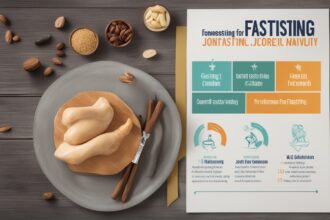Fasting has long been recognized for its potential health benefits, from weight loss to improved metabolic health. Among its emerging applications is the role it may play in supporting joint health, particularly through intermittent fasting. For those struggling with joint pain and inflammation, exploring intermittent fasting joint inflammation relief could offer a natural approach to managing symptoms. In this comprehensive guide, we’ll delve into how intermittent fasting may help reduce joint inflammation, the science behind it, and practical tips for incorporating this practice into your lifestyle.
What Is Intermittent Fasting and How Does It Work?
Intermittent fasting (IF) is an eating pattern that alternates between periods of eating and fasting. Common methods include the 16/8 approach (fasting for 16 hours and eating during an 8-hour window) or the 5:2 method (eating normally for five days and significantly reducing calorie intake for two days). During fasting periods, the body shifts from using glucose as its primary energy source to burning stored fat, entering a state called ketosis. This metabolic switch is believed to trigger anti-inflammatory processes that could contribute to intermittent fasting joint inflammation relief.
Beyond weight loss, intermittent fasting influences various physiological processes, including autophagy—a cellular “clean-up” mechanism that removes damaged cells and reduces inflammation. For individuals with joint conditions like arthritis, this anti-inflammatory effect may provide much-needed relief. To learn more about the basics of fasting, check out our post on Fasting 101: A Beginner’s Guide.
The Link Between Inflammation and Joint Health
Chronic inflammation is a key driver of joint pain and degenerative conditions such as osteoarthritis and rheumatoid arthritis. When the body is in a constant state of inflammation, immune responses can attack healthy tissues, including the cartilage and synovial fluid in joints, leading to pain, stiffness, and swelling. Lifestyle factors like poor diet, stress, and lack of exercise can exacerbate inflammation, worsening joint health over time.
Intermittent fasting may help by lowering levels of pro-inflammatory markers like C-reactive protein (CRP) and interleukin-6 (IL-6). By reducing systemic inflammation, IF could play a role in intermittent fasting joint inflammation relief, potentially easing discomfort for those with joint issues. For more insights on inflammation and its impact on the body, read our article on Understanding Chronic Inflammation and Its Effects.
Scientific Evidence Supporting Intermittent Fasting for Joint Inflammation
While research on intermittent fasting and joint health is still in its early stages, several studies suggest promising results. Animal studies have shown that fasting can reduce inflammation and protect against cartilage degradation, a key factor in osteoarthritis. Human studies, though limited, indicate that intermittent fasting may lower inflammatory markers and improve symptoms in autoimmune conditions like rheumatoid arthritis.
For instance, a 2019 study published in the journal Cell found that fasting triggers metabolic changes that suppress inflammation. These findings suggest a potential mechanism for intermittent fasting joint inflammation relief. However, more clinical trials are needed to establish definitive benefits for joint-specific conditions. If you’re curious about the broader benefits of fasting for autoimmune diseases, explore our post on Fasting and Autoimmune Conditions.
Practical Tips for Using Intermittent Fasting to Support Joint Health
If you’re considering intermittent fasting to manage joint inflammation, it’s important to start slowly and tailor the approach to your needs. Here are some practical tips to help you get started:
- Choose a Sustainable Fasting Schedule: Beginners might try the 12/12 method (fasting for 12 hours overnight) before progressing to more intensive protocols like 16/8.
- Stay Hydrated: Drink plenty of water during fasting periods to support joint lubrication and overall health.
- Focus on Anti-Inflammatory Foods: When breaking your fast, prioritize nutrient-dense foods like fatty fish, leafy greens, and berries, which can further reduce inflammation.
- Listen to Your Body: If you experience increased joint pain or fatigue, adjust your fasting schedule or consult a healthcare provider.
Combining intermittent fasting with other joint-friendly practices, such as low-impact exercise, can maximize benefits. For exercise ideas, see our guide on Low-Impact Exercises for Joint Health.
Potential Risks and Considerations
While intermittent fasting shows promise for reducing inflammation, it’s not suitable for everyone. Individuals with certain medical conditions, such as diabetes or eating disorders, should avoid fasting unless under medical supervision. Additionally, fasting can sometimes lead to temporary side effects like hunger, irritability, or fatigue, which may indirectly affect joint comfort if stress levels rise.
Pregnant or breastfeeding individuals, as well as those on specific medications, should consult a healthcare provider before starting any fasting regimen. To understand more about who should avoid fasting, refer to our article on Fasting Safety: Who Should Avoid It?.
How to Monitor Progress and Adjust Your Approach
When using intermittent fasting for joint health, tracking your progress can help you determine its effectiveness. Keep a journal to note changes in joint pain, stiffness, or mobility over time. Pay attention to other indicators, such as energy levels and overall well-being, as these can also reflect the impact of fasting on inflammation.
If you don’t notice improvements after a few weeks, consider adjusting your fasting window, dietary choices, or consulting a nutritionist for personalized advice. Remember that intermittent fasting is just one tool in a broader strategy for joint health, and combining it with medical treatments or physical therapy may yield the best results.
Disclaimer: This content is for informational purposes only and not a substitute for professional medical advice. Always consult with a qualified healthcare provider before making significant changes to your diet or lifestyle, especially if you have pre-existing health conditions or concerns about joint health.
References
- Anton, S. D., et al. (2019). Fasting or caloric restriction for healthy aging. Cell.
- Longo, V. D., & Mattson, M. P. (2020). Fasting: Molecular mechanisms and clinical applications. Nature Reviews Molecular Cell Biology.
- Arthritis Foundation. (n.d.). Intermittent Fasting and Arthritis.
- Harvard Health Publishing. (2018). Intermittent fasting: Surprising update.
- Mayo Clinic. (n.d.). Intermittent fasting: Is it right for you?






